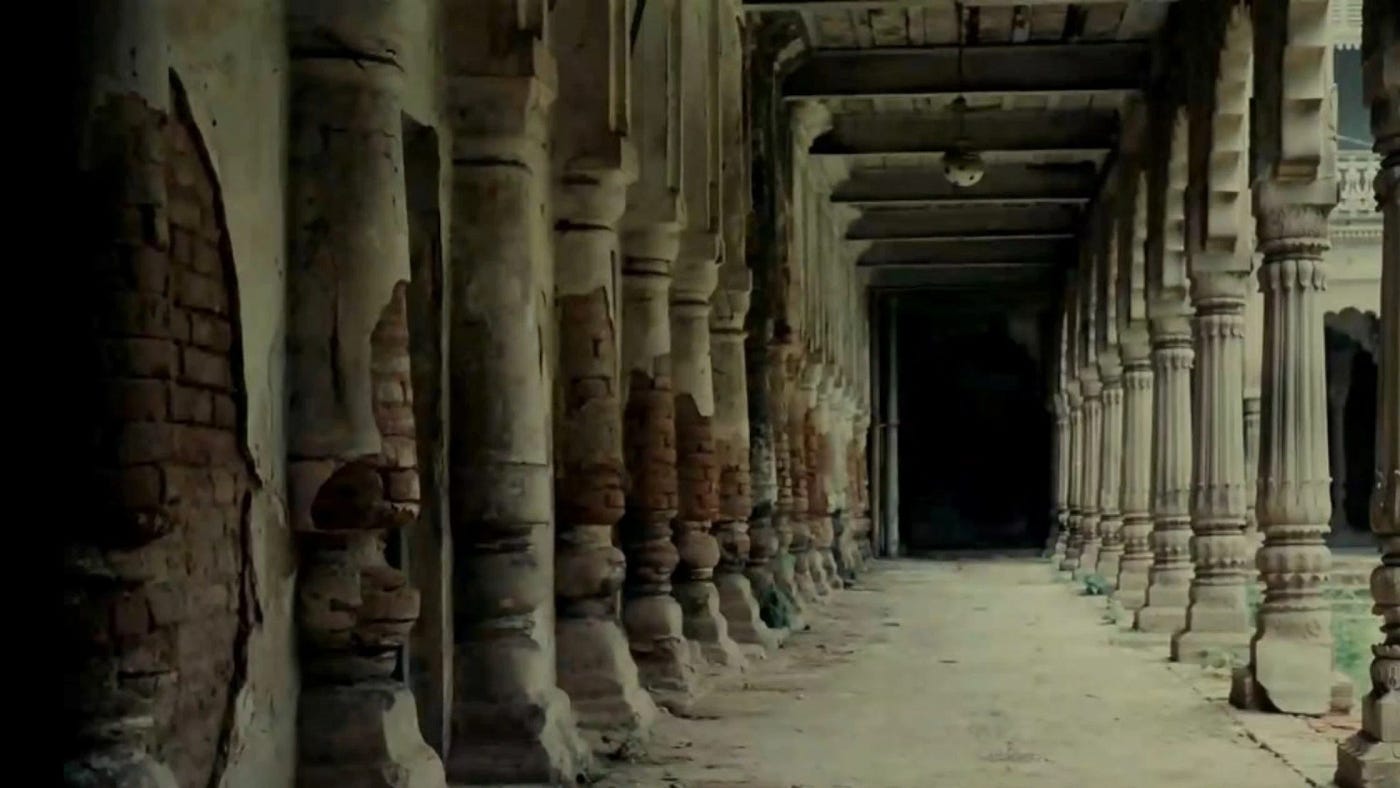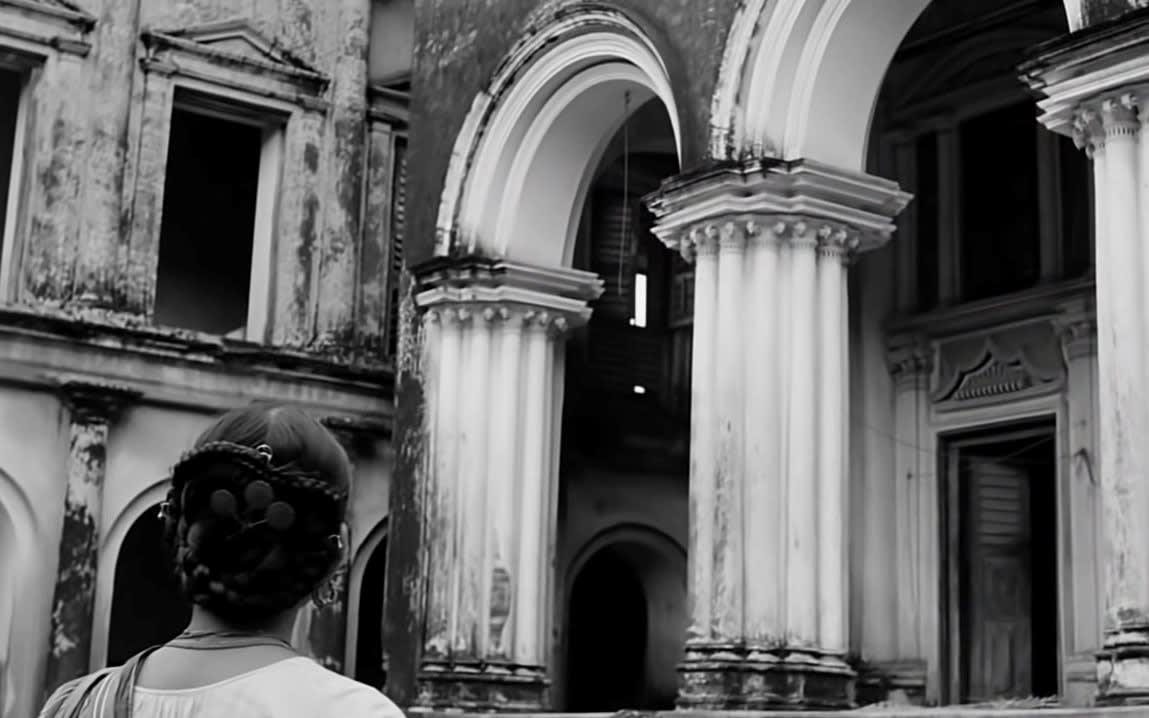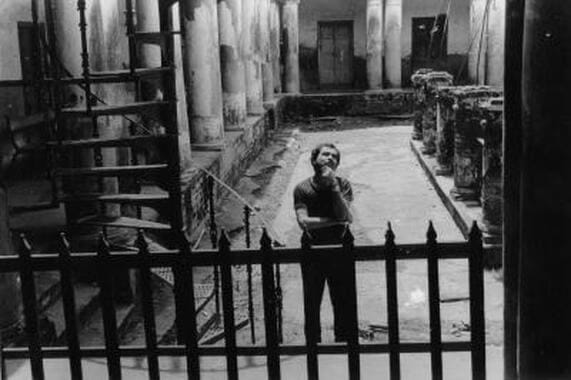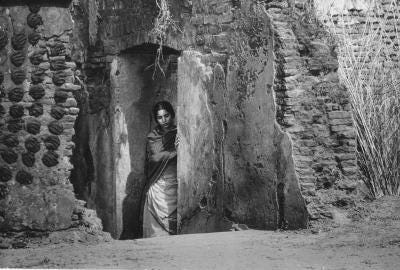
“Night grinds on and the huge decrepit mansion continues talking in unceasing whispers…” — Ek Din Pratidin (1980)
“From Baishey Shravan in 1960 … ‘ruins’ have played an important role in many of my films.” — Always Being Born
All of us have, at some time or another, imbued the houses we have lived in with a range of emotions. A childhood home can be remembered with as much warmth as a family member. A house where we encountered trauma can trigger feelings of misery. Thoughts about a ramshackle house can make us feel trapped.
Houses, although lifeless shapes made of very base ingredients, are strong receptacles of thoughts and emotions, and can even become part of our collective consciousness.
Think of the Taj Mahal, of Rabindranath Tagore’s house, Arundhati Roy’s house, or Shah Rukh Khan’s house. Whether or not you’ve seen these in person, you certainly have some reaction to what each of these represents. Most likely, they take on the persona of their famous residents and your association with the house is the same as your association with the resident.
Mrinal Sen was known to have a fondness for situating his films in expansive but decrepit houses out of his ‘love for ruins’. One of his early films, Baishey Shravana (1960), was close to his heart not just because it brought him success and respect, but also because he felt he had gotten very lucky by chancing upon the mansion that featured in the film.

In the film, a young bride is leading her husband on a playful chase through their village home when she finds she has run into the courtyard of an old, abandoned, yet awe-inspiring mansion that belonged to his forebears. Her husband tells her of the mansion’s glory days and how it collapsed from there. In a sequence that lasts only a few minutes, we see how the mansion is an entire period’s history frozen in one architectural unit. In its form, it contains stories of prosperity and atrocity, generations of family history, and social history in the form of parties and festivals. Once an abode for the living, the tales of the dead are all that remain among the bricks. The grandeur has ‘evaporated like camphor’.
Years later, Sen made something of a meta-film about his experience shooting Baishey Shrabon. This was Akaler Sandhaney (1980) for which he used an even larger house as the setting. In the movie, the film crew takes up residence in this former mansion and their days of shooting get a much-needed warm communal feel. By living together, the cast and crew become more close to the theme of the film they are working on. They speak to the locals who crowd the set. They even become witnesses to a death in the family and mourn as family members would. Somehow, the group of strangers becomes connected like inmates in a hostel. A house brings together strangers who had no shared history previously. Living under the same roof collapses differences and forms a familial unit.

But the reverse can also happen, as in Ek Din Pratidin (1979). Even before we are introduced to any of the main characters of the film, a voice-over introduces us to the house where the film is situated. We are told when and by whom it was built and how it passed hands through generations till the current owner, much poorer than his ancestor, is forced to give the rooms out on rent. Like the famous Mumbai chawls, here too we find families living with no real sense of privacy. One never knows on which days this may help strengthen bonds among the neighbours, or when it may lead to confrontations. A missing woman from one household becomes a cause for concern, a subject of derision, a source of inspiration, and a trigger for anger. Everything happens within a huge house where words and lives flow without barriers. Tensions flare up among the inmates and the landlord, and the mansion consumes it all without flinching.
Our final example is Sen’s Hindi film Khandhar (1983). The house in this film is probably the most remote (within the fictional world) of all the ones Sen depicted. It takes an inordinately long journey by bus and bullock cart to reach there. Once revealed, it is more a ruin than a house, and fit for photography but not inhabitation. And yet there are inhabitants, a mother and daughter duo, and their father-daughter domestic staff. The mother is bedridden and feels entombed within the structure even as she has a few breaths remaining. The daughter, however, is trapped like a forgotten bird in a cage. She aches to belong to the world outside but her mother has nobody else to look after her. As the world has moved on without her, the daughter has become a human ruin, like the house she lives in. Without attention, and wracked by loneliness, nothing remains of the original beauty and strength. Those who visit, see the pain and suffering, but go away after capturing a few photographs, as a ruin, once it has collapsed in on itself, cannot be reconstructed.

Dipankar Mukhopadhyay’s excellent biography of Sen has the following passage that best sums up how the imagery of old mansions influenced Sen’s filmmaking choices. It is about the time when Sen and his team were scouting for locations for Baishey Shravana.
“One hot summer afternoon, when they were driving around Burdwan district without much luck, the famous nor-wester of Bengal struck them in full fury. They had to stop the car and wait for the storm to pass by. It was an awe-inspiring sight. As they watched the beauty of the storm spellbound, Bansi Chandragupta spotted the ruins of an old mansion. When the storm subsided, the building looked magnificent against the last rays of the sun. Looking at it, Sen first got the idea of the famous storm sequence. Such a sequence was neither part of the original story nor of the script already written by him. The storm brought back memories of his distant childhood when he was mortally scared of rain and thunder. He remembered how he would cling to his mother and close his eyes, terrified that the world was coming to an end, as monsoon winds and rain lashed his home in Faridpur. Sen thought of making his irrational fear of childhood an integral part of the script.”
We must be thankful to that mansion for braving the storm.
References
Mrinal Sen, Always Being Born — A Memoir, Steller Publishers, 2006
Dipankar Mukhopadhyay, Mrinal Sen — Sixty Years in Search of Cinema, Harper Collins, 2009
Originally published at https://indigenousweb.com.
Leave a Reply